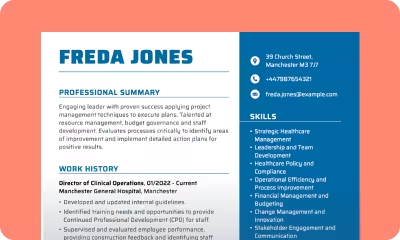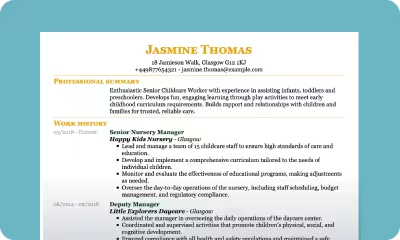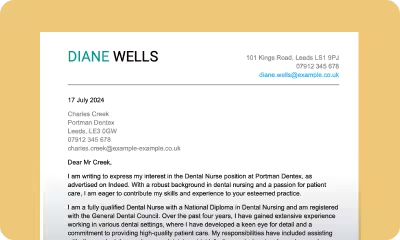- Our customers have been hired by : *Foot Note
A research assistant works as part of a research team to conduct projects or experiments in a specific field. Research assistants benefit from a diverse career path, having the choice to work in many industries – from engineering to education.
While the research assistant role is no doubt an exciting one, the labour market for research assistants is somewhat uncertain at the moment, with overall demand declining. As a result, landing your desired job will require you to really go the extra mile. This starts with a well-crafted research assistant cover letter, which will allow you to showcase your relevant skills, experience and a genuine enthusiasm for the role you are pursuing.
To find out how to write, structure and format your research assistant cover letter, check out our cover letter examples. These will guide you through the whole process and allow you to create a cover letter that will make a statement.
Research Assistant Cover Letter Sample
Create a powerful research assistant cover letter with the help of our cover letter templates. Studying these will give you an idea of how to write, structure and format your own cover letter. Taking the time to make sure your cover letter is of a high standard is sure to pay off in the end.
Take a look at some cover letter templates we’ve prepared for you below, and take note.
Anna McDonald
195 Crown Street
London W12 4WB
07912 345 678
anna.mcdonald@example.co.uk
29 July 2024
Ben Worthington
King’s College London
Strand
London
WC2R 2LS
b.worthington@kingscollegelondon.co.uk
Dear Mr Worthington,
I am writing to express my enthusiasm for the Research Assistant position at King’s College London (KCL) as advertised on your careers page. With a robust academic background in biology, complemented by hands-on research experience and a passion for advancing knowledge, I am eager to contribute to the innovative research initiatives at KCL.
During my internship at Parexel, I collaborated with a multidisciplinary team to support various research projects. My responsibilities included conducting literature reviews, designing experiments, and managing data collection processes. I also contributed to the preparation of research reports and presentations, which honed my ability to communicate findings effectively. This experience has not only enhanced my technical skills but also underscored the importance of teamwork and meticulous attention to detail in research endeavours.
Moreover, I possess strong organisational and time-management skills, which are crucial for balancing multiple tasks and meeting deadlines in a fast-paced research environment. My ability to work independently and as part of a team ensures that I can adapt to different working styles and contribute effectively to collaborative projects.
I am excited about the opportunity to join the research community at King’s College London and contribute to its mission of fostering innovation and excellence. I am confident that my skills and experiences make me a strong candidate for this position, and I look forward to the possibility of discussing how I can contribute to your research team.
I have attached my CV for your review and would be delighted to discuss the opportunity further at your earliest convenience.
Yours sincerely,
Anna McDonald
How to Write a Research Assistant Cover Letter
Your research assistant cover letter is your first opportunity to build a connection with the hiring manager. Unlike a CV, which is usually a list of qualifications and experiences, a cover letter allows you to showcase your personality, enthusiasm, and all the relevant skills. This personal touch can go a long way, making you stand out from the competition.
Writing a great cover letter may seem a bit intimidating, but that’s exactly why we’ve prepared a step-by-step guide below that will walk you through the process. Keep reading to find out how to create a research assistant cover letter that will impress employers.

Your research assistant cover letter step by step:
Step 1: Browse Cover Letter Examples
Before you set about creating your own cover letter, it’s always a good idea to have a look at examples of cover letters tailored to the research assistant role. Browse our website for examples of research assistant cover letters, and make note of how they’re formatted, structured and what kind of information is included. Studying professional examples of cover letters is a great starting point, sure to help you create a great cover letter of your own.
Step 2: Add Contact Information and Date
While this may seem like a minor detail, formatting your contact information correctly is key to a professional-looking cover letter. So, make sure to start your cover letter with your contact information at the very top. Include your full name, home address, phone number and your email.
Make sure to leave a space underneath your contact information, followed by the date. Following another space, write the contact information of the person you are addressing. Add their full name as well as the company name, postcode, and their email address.
In the end, you should end up with something that looks like this…
Samantha James
4 Bold Street
Liverpool L1 4JG
07912 345 678
samantha.james@example.com
29.07.2024
Alex Smith
Pfizer
Kent CT13 9NJ
+44 151 709 2203
a.smith@pfizer.co.uk
Step 3: Open with a Salutation
It’s generally considered good manners to address the hiring manager by their name. See if you can find their name in the job description, the company website, or even LinkedIn. This seemingly little detail can make a real difference to how your cover letter is received.
Of course, you may not be able to find the hiring manager’s full name despite your best efforts. In this case, go with “Dear Hiring Manager” as an alternative.
Be sure to avoid generic greetings such as “To Whom It May Concern” or “Dear Sir or Madam”. These are not only vague, but they also create a tone that is a bit too on the formal side, which is not something you want when trying to build a connection with the hiring manager.
Dear Mr. Worthington
OR
Dear Hiring Manager
Step 4: Write a Gripping Introduction
Your opening paragraph should grab the reader’s attention. This is your first opportunity to make a great first impression, so take advantage of it.
After addressing the hiring manager, specify the position you are applying for and where you found the listing. Introduce yourself, state why you believe you are the right fit for the role, and be sure to express your eagerness to join the company.
I am writing to express my interest in the Research Assistant position at Via Community Ltd., as advertised on your company website. With a Master’s degree in Biology from Glasgow University and substantial experience in community-focused research, I am enthusiastic about the opportunity to contribute to Via Community Ltd.’s mission of enhancing social wellbeing.
OR
I would like to submit my application for the Research Assistant position at Parexel, as advertised on LinkedIn on July 26th. As a lifelong learner with a Master’s degree in Biomedical Science, I am interested in the prospect of working as part of a team at Parexel and contributing to your clinical research. As I forge ahead in my career, I am confident that this research assistant role would allow me to expand my professional and academic horizons, while contributing effectively to your ongoing research.
Step 5: Describe Your Qualifications
To convince the hiring manager of your suitability for the advertised position, you need to describe your qualifications and everything else you bring to the table. When applying for a research assistant role, it’s important to demonstrate that you possess hard skills such as data analysis, research methodology and laboratory skills, as well as soft skills such as communication, attention to detail and time management.
Be sure to explain how your qualifications and experience have prepared you to contribute in the role you are applying for.
During my internship at King’s College London, I had the opportunity to assist in several research projects that required meticulous data entry, literature reviews, and report writing. I collaborated closely with senior researchers to design experiments, collect data, and analyse results. My role required a high level of precision and attention to detail, ensuring that all data was accurately recorded and analysed. This experience honed my analytical skills and reinforced my commitment to maintaining the highest standards of research integrity.
OR
I hold a Master’s degree in Biology from King’s College London, where I gained comprehensive training in both qualitative and quantitative research methodologies. My thesis, “Ways of speeding up vaccine development and testing” involved rigorous data collection and analysis, utilising software such as SPSS and R, which prepared me to handle complex datasets and extract meaningful insights. Additionally, my coursework in “Infection, immunity and public health” has equipped me with a strong theoretical foundation and practical skills essential for conducting high-quality research.
Step 6: Close On an Enthusiastic Note
Finish your research assistant cover letter, by conveying your enthusiasm and eagerness to join the team. Explain what it is that has drawn you to the company, and how that fits in with your skills, qualifications and experience. The conclusion is your last opportunity to leave a lasting impression on the hiring manager, so don’t underestimate its importance.
UCL’s commitment to excellence in research and innovation resonates with my professional aspirations. I am particularly drawn to UCL’s cancer research, as I believe my background and skills align well with the objectives of this project. I am confident that my dedication, combined with my academic and professional background, make me a strong candidate for this position. I look forward to the possibility of discussing how my experiences and skills can contribute to the continued success of your research initiatives.
OR
I am excited about the opportunity to join the research community at King’s College London and contribute to its mission of fostering innovation and excellence. I am confident that my skills and experiences make me a strong candidate for this position, and I look forward to the possibility of discussing how I can contribute to your research team.
Step 7: End with a Professional Sign-Off
Finish your cover letter with a professional sign-off for a polished look. Thank the hiring manager for their time and end with either “Yours sincerely” (if you’ve used the recipient’s name in your salutation) or “Yours faithfully” (if you went with a more impersonal greeting). However, it’s not unusual to close with a less formal sign-off such as “Kind regards” or simply “Sincerely”.
Thank you for considering my application. I am enthusiastic about the opportunity to discuss how my skills and experiences align with the needs of your practice.
Yours sincerely,
Samantha James
OR
Thank you for taking the time to consider my application. I would welcome the opportunity to discuss how my background, skills, and certifications can be beneficial to your practice.
Kind regards,
Samantha James
Step 8: Check Your Formatting
A consistent cover letter format is just as important as the content of your cover letter, so spend some time making sure all is in order. In terms of font, your best bet is to go with Arial, Times New Roman or Calibri, while keeping the font size between 10 and 12 points. For best readability go with 1-inch margins and consistent spacing throughout.
And of course, give your cover letter a good read before sending it off to weed out any grammatical and typographical errors that could very well spoil your whole presentation.
Complete Your Research Assistant Application
Make that research assistant job yours with a professionally written research assistant CV on top of your cover letter. Make use of cover letter and CV builders for an impeccable application that is sure to impress hiring managers and show you’re serious about the role.
Frequently Asked Questions About a Research Assistant Cover Letter
How to write a research assistant cover letter with no experience?
While experience is highly important in the research field, not having any doesn’t mean you can’t get your foot in the door. Your cover letter is your opportunity to showcase all the other assets you bring to the role besides experience. These can be anything from part-time positions, volunteering or extracurricular activities that have allowed you to develop the skills necessary to get a start as a research assistant. Be sure to convey your enthusiasm for the role and your eagerness to contribute to the team.
What to include in a research assistant cover letter?
A research assistant cover letter should most importantly emphasise the necessary skills you bring to the role. These include data analysis, research methodology, laboratory skills and competence in using databases, Microsoft Office Suite and other research-related software. Soft skills such as communication, teamwork, attention to detail and time management are also highly valued, and should definitely be highlighted in your cover letter.
Apart from the above, mentioning your previous experience and the contribution you’ve made in your past roles is also sure to go down well with hiring managers, who are on the lookout for highly motivated and effective individuals.
How long should a research assistant cover letter be?
When it comes to the ideal length of a cover letter, keeping to 250-400 words is best. This should give you enough space to showcase your assets without compromising readability. Hiring managers are busy people, and they’re sure to appreciate a cover letter that is concise and to the point.
Supercharge Your Research Assistant Career
Advance your research assistant career with a polished cover letter that shows all that you have to offer. Take advantage of our cover letter templates and examples, and other resources to create a cover letter that makes an impression on hiring managers.
*The names and logos of the companies referred to above are all trademarks of their respective holders. Unless specifically stated otherwise, such references are not intended to imply any affiliation or association with myperfectCV.



